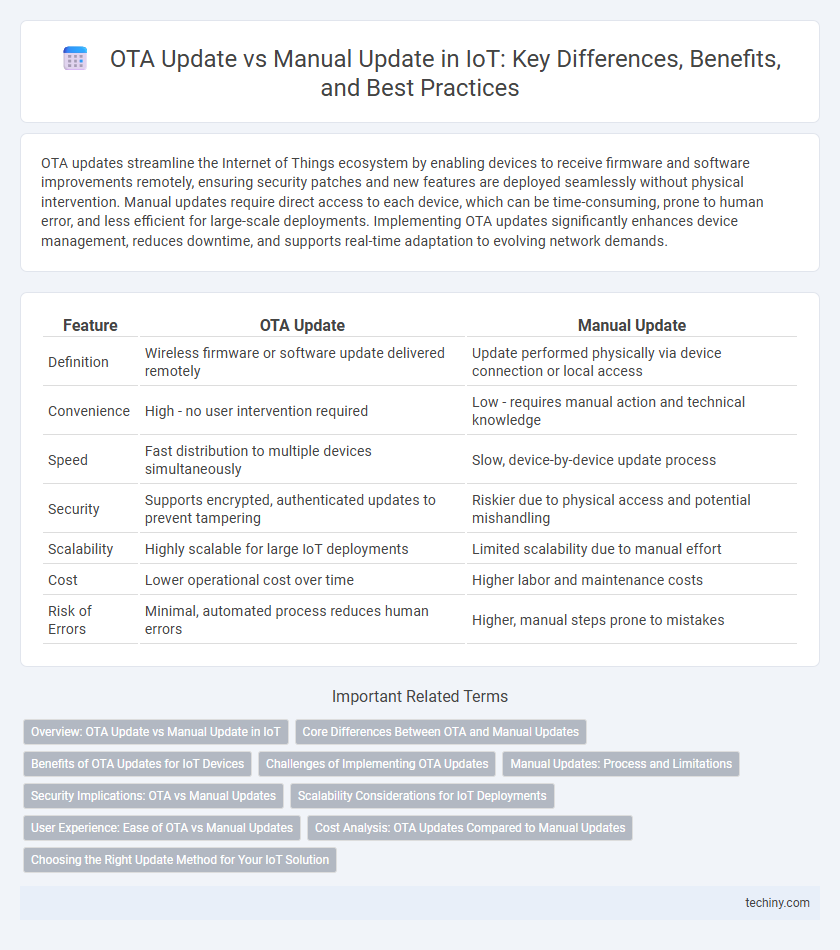OTA updates streamline the Internet of Things ecosystem by enabling devices to receive firmware and software improvements remotely, ensuring security patches and new features are deployed seamlessly without physical intervention. Manual updates require direct access to each device, which can be time-consuming, prone to human error, and less efficient for large-scale deployments. Implementing OTA updates significantly enhances device management, reduces downtime, and supports real-time adaptation to evolving network demands.
Table of Comparison
| Feature | OTA Update | Manual Update |
|---|---|---|
| Definition | Wireless firmware or software update delivered remotely | Update performed physically via device connection or local access |
| Convenience | High - no user intervention required | Low - requires manual action and technical knowledge |
| Speed | Fast distribution to multiple devices simultaneously | Slow, device-by-device update process |
| Security | Supports encrypted, authenticated updates to prevent tampering | Riskier due to physical access and potential mishandling |
| Scalability | Highly scalable for large IoT deployments | Limited scalability due to manual effort |
| Cost | Lower operational cost over time | Higher labor and maintenance costs |
| Risk of Errors | Minimal, automated process reduces human errors | Higher, manual steps prone to mistakes |
Overview: OTA Update vs Manual Update in IoT
OTA updates in IoT enable seamless, remote firmware and software upgrades, reducing downtime and minimizing the need for physical device access. Manual updates require on-site intervention, increasing operational costs and limiting scalability across widespread IoT deployments. OTA provides enhanced security and efficiency by delivering timely patches and feature enhancements over the air, crucial for maintaining device integrity and functionality in dynamic IoT environments.
Core Differences Between OTA and Manual Updates
OTA updates in the Internet of Things enable remote, real-time software or firmware upgrades across connected devices without physical intervention, enhancing efficiency and reducing downtime. Manual updates require direct device access for installation, often causing delays and increased labor costs, particularly in large-scale deployments. Key differences include automation level, update speed, scalability, and risk of human error, with OTA offering streamlined, secure distribution and manual updates demanding more resources and time.
Benefits of OTA Updates for IoT Devices
OTA updates enable seamless remote firmware enhancements for IoT devices, significantly reducing downtime and maintenance costs. They enhance security by promptly patching vulnerabilities, ensuring devices remain protected against evolving cyber threats. Automated deployment of OTA updates supports scalability and consistent performance across extensive IoT networks without requiring physical intervention.
Challenges of Implementing OTA Updates
Implementing OTA updates in Internet of Things (IoT) devices faces challenges such as ensuring secure data transmission to prevent cyberattacks and maintaining device battery efficiency during the update process. Compatibility issues arise due to diverse hardware and firmware versions across IoT ecosystems, complicating seamless update deployment. Network reliability and bandwidth limitations further hinder consistent OTA update delivery, risking incomplete or failed installations.
Manual Updates: Process and Limitations
Manual updates in the Internet of Things (IoT) require physically accessing each device to install firmware or software changes, which is time-consuming and labor-intensive for large-scale deployments. These updates often lead to inconsistent device versions due to human error, increased downtime, and elevated operational costs. Limited scalability, delayed security patch applications, and lack of automation highlight major drawbacks compared to Over-the-Air (OTA) updates.
Security Implications: OTA vs Manual Updates
OTA updates enhance IoT security by delivering timely patches and firmware improvements directly to devices without physical access, significantly reducing exposure to vulnerabilities. Manual updates rely on physical intervention, increasing the risk of delayed patches and human error, which can leave devices susceptible to cyberattacks. Secure OTA protocols with encryption and authentication ensure integrity and prevent unauthorized access during the update process, whereas manual methods often lack standardized security measures.
Scalability Considerations for IoT Deployments
OTA updates enable scalable IoT deployments by remotely distributing firmware improvements across thousands or millions of devices simultaneously, reducing downtime and logistical complexity. Manual updates require physical access to each device, limiting scalability and increasing operational costs and time for large-scale IoT networks. Efficient OTA update mechanisms support seamless, rapid deployment and enhance device security and performance at scale.
User Experience: Ease of OTA vs Manual Updates
OTA updates simplify the user experience by enabling seamless, remote installation of software improvements without requiring physical interaction with the device. Manual updates often demand technical knowledge and device accessibility, leading to potential user frustration and higher risk of errors during installation. The convenience of OTA updates enhances device reliability and user satisfaction by delivering timely updates effortlessly.
Cost Analysis: OTA Updates Compared to Manual Updates
OTA updates significantly reduce operational expenses by eliminating the need for physical technician visits and minimizing device downtime, leading to faster deployment and lower labor costs. Manual updates incur higher costs due to on-site maintenance, travel expenses, and prolonged system interruptions affecting productivity. The scalability of OTA updates further enhances cost efficiency by enabling simultaneous over-the-air firmware distribution to thousands of IoT devices without incremental expenses.
Choosing the Right Update Method for Your IoT Solution
Selecting the appropriate update method for your IoT solution hinges on device scale, network reliability, and security requirements. OTA updates provide seamless, automated deployment with minimal downtime, ensuring devices receive timely patches and feature enhancements. Manual updates offer granular control in isolated or sensitive environments but increase maintenance overhead and risk of inconsistent firmware versions across the network.
OTA update vs Manual update Infographic

 techiny.com
techiny.com